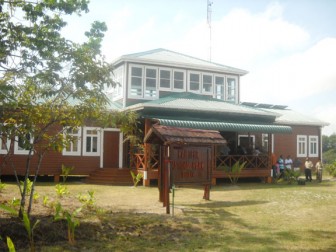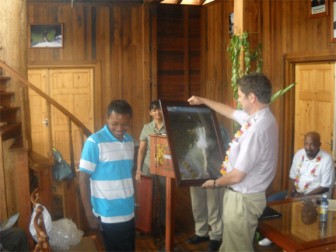A state of the art visitor arrival centre was commissioned in the Kaieteur National Park (KNP), Region 8 yesterday.
The centre, which was built at a cost of $54M, is located close to the Kaieteur airstrip, less than an hour‘s walking distance from the majestic Kaieteur Fall.
At a small ceremony at the centre yesterday morning, General Manager of the National Parks Commission, Yolanda Vasconcellos noted that the agency has been implementing several measures to improve the biodiversity of the area for the past several years. She said that the project has been in the pipeline for a number of years courtesy of funding from the KfW (German government development bank). The facility accommodates a cafeteria, improved communication (radio and telephone) as well as a gallery.
She said that the aim is to “promote a better understanding and appreciation of work in protected areas“ and it will complement other revenue-generating ventures aimed at sustaining the area.

Speaking at the commissioning ceremony, Chairman of the Kaieteur National Park (KNP) Board Shyam Nokta described the completion of the wooden centre as a milestone for the park. He said that the German-funded project provided three major benefits to the area, ie the training and equipping of wardens and development of the nearby Chenapau community; the completion of the Tukeit guest house which will further enhance accommodation at Kaieteur; and the visitor arrival centre.
He said that the centre was conceptualized in 1999 by the KNP board, but that funding for the project was critical; it was completed at a cost of some $54M. The centre was built and furnished with Guyanese expertise, however, utilizing local materials and employing solar power.

Nokta said that the centre serves as a point of orientation for visitors, providing vital information and generating revenue to help maintain the park.
He said that the Germans have provided critical support to the sector, including infrastructural development and this has made a significant difference in the development of the tourism sector. He said that the authorities were looking forward to the second phase of the project which will include the improvement of key facilities at the park.
Nokta noted that over the years the management of the park has been working to improve facilities and conditions in the area and that the modest guesthouse has been upgraded.
The relevant sector agencies have been working with the Tourism Ministry to raise the image of Kaieteur via marketing and development, Nokta continued, saying that the next priority will be the establishment of eco-lodges.
He said that training of wardens, who will be equipped to conduct tours at Kaieteur, will be unveiled in another few months.
Germany’s non-resident Ambassador to Guyana, Stefan Schlueter observed that while it was his first visit to the site, he has read numerous articles about the area. He described the site as a treasure which has to be protected, and expressed the view that tourism was one of several key industries in the developing world. However, while the sector has its benefits, he said, it can also destroy the environment.
Schlueter said that Germany will continue to work with the Government of Guyana in terms of providing support to key projects, a partnership which began in 1994. He said that the German government has pledged economic support geared at providing development in Amerindian communities, and that approximately €8M has been set aside in this respect. The Ambassador commented too that Guyana is the only nation in the region which has established bilateral relations with Germany.
Over the past two years the tourist site has seen a steady increase of visitors from 2247 in 2001 to 4253 in 2010 an almost 100% rise. At the same time, the revenue generated increased from $50,000 in 2001 to $500 000 in 2010.
Yesterday, the first official telephone call was made from the area by PPP General Secretary Donald Ramotar, who along other government officials called for the facility to be maintained.
The KNP was established in 1929 and covers an area of 627 square kilometres. It is situated on the Guiana Shield, one of one of the world’s oldest geological formations. In the past, there were no human settlements in the area according to the National Parks Commission, with the nearest community being Chenapau located some 35 miles up the Potaro River from the falls. However, with the introduction of the airstrip and the expansion of mining in the area, a transient community of scattered buildings at Menzies Landing was established, some of whose residents have lived there for the better part of 15 years.





